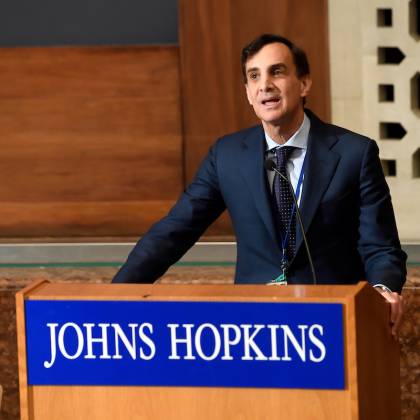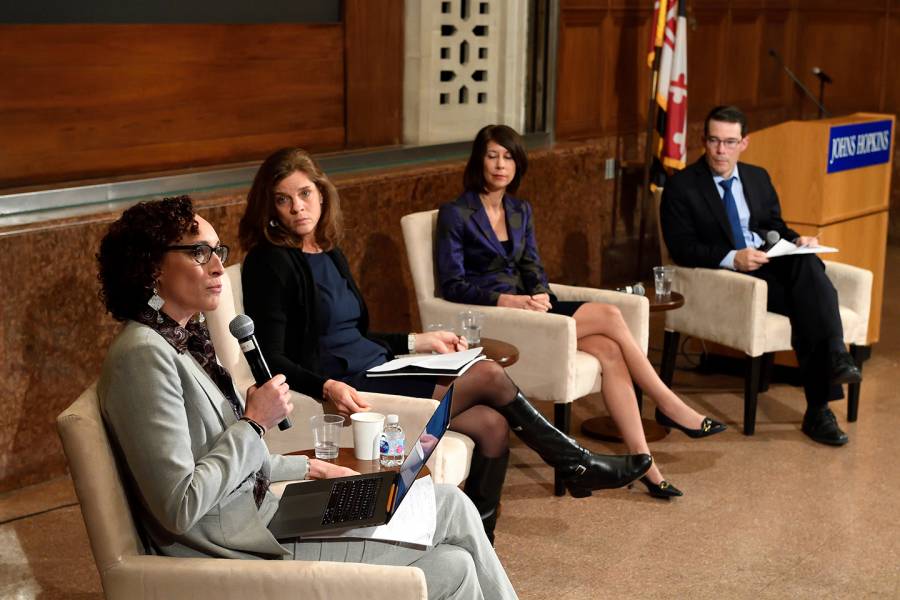Johns Hopkins University held the second public discussion in its series titled The Challenges of 21st Century Policing on Friday, Nov. 9, featuring a faculty-led panel discussion about constitutional policing and police accountability.
The three-part discussion series, two open forums with university leaders, and meetings with university and community organizations represent the university's ongoing effort to engage with students, faculty, staff, and neighbors as Hopkins considers options to augment its security operations.
In his opening remarks Friday, JHU President Ronald J. Daniels said the discussion was a chance to learn about policing models that follow the rule of law while fostering public trust.
He also acknowledged that such nuanced public discussions didn't take place last fall, when the university first suggested the need for its own police department while facing an uptick in crime near its Baltimore campuses.

Image caption: President Ronald J. Daniels provided opening statements
Image credit: Will Kirk / Johns Hopkins University
"This is a really important conversation we are having that, in truth, was compressed last year," Daniels said. "We want to join the conversation around many of our communities—not just on campus but off—because we know that the power we are asking for, though it's a power that is widely held in our peer group, is a very serious power that has very serious implications for the institution and its impact on our community."
The discussion took place at Johns Hopkins Hospital's Hurd Hall and was moderated by Daniel Webster, professor of health policy and management at the Johns Hopkins Bloomberg School of Public Health and director of its Center for Gun Violence Policy and Research, who said panelists were eager to talk about what good policing should look like.
"There's a lot more to police–community relations than just policing in a lawful manner," said Nancy La Vigne, vice president for justice policy at the Urban Institute. "You can be lawful and awful at the same time."
Christy Lopez, distinguished visitor from practice at Georgetown Law School and former deputy chief in the Special Litigation Section of the Civil Rights Division at the U.S. Department of Justice, agreed: "Even lawful and not awful is nonetheless an intrusion on one's life and that's born disproportionately on poor people and communities of color. So why are we policing them? What is the problem we are trying to solve? We know that police are not the primary driver of bringing down violence or increasing public safety, so we have to keep that in mind."
Vesla Weaver, a Bloomberg Distinguished Associate Professor of Political Science and Sociology at Johns Hopkins who specializes in researching issues surrounding criminal justice, racial inequality, and American democracy, read excerpted stories told by black residents of Baltimore about their problematic experiences with policing. One was the story of a young man who remembered being handcuffed when he was 11 because he and his friends were having a water-balloon fight. He recalled being labeled as a gangster and a criminal from that day forward.
"The majority of encounters like this are happening before the young, impressionable age of 14," Weaver said.
"My best practice is make policing a very last resort as it pertains to kids because that is often the onramp to further contact with the criminal justice system," Weaver added. "It's something that doesn't have an easy fix beyond limiting it drastically. Does that make me a police abolitionist? It might. I don't think we have any good models in this country today, and we won't get there until we have conversations about gun control, or lead in the water, or the multigenerational passing down of wealth or poverty."
Graduate students from both the East Baltimore and Homewood campuses were in the audience and shared their thoughts and experiences.
A PhD candidate in the School of Nursing lamented that the university appears to be placing a premium on the safety of its students at the expense of the city's more vulnerable populations. She suggested that it is Hopkins' excellence in public health—not enhanced security—that will change Baltimore for the better.
Daniels agreed that the university's responsibilities go well beyond public safety on and around its campuses—and highlighted the university's ongoing long-term commitments in Baltimore on education, health, and economic opportunity—but he added that the city's present struggles with crime and violence cannot be ignored.
"From the moment I got to Baltimore and saw the relationship between the university and the city, I have been unrelenting about the fact that Johns Hopkins is not at or in, but of the city, and we have to behave in a manner that demonstrates that commitment," Daniels said.
"As much as we are trying to make an impact, we still have a near-term problem that we have to address. The long-term solution is not a police corridor—the solution is making this community stronger. That starts with education, social policies, addressing problems with lead paint, nutritional issues. And it's jobs, and that's where we are being helpful. There's no doubt that there's more we can do, but please understand that it's not an afterthought. It's the core of what we bring to the city."

Image credit: Will Kirk / Johns Hopkins University
Toward the end of the event, a graduate student shared that police officers at his undergraduate institution had prevented a roommate, who had run away, from attempting suicide. He suggested a police department at Hopkins could be more than a crime-fighting force, but potentially a life-saving resource.
Lopez said she was glad the discussion was ending on that note because it showed the complexity of community policing.
"Harm reducing rather than harm adding—what we need is for the kind of interaction you experienced to be the norm," she said. "That was a task that a police force is uniquely trained to do. That wasn't just a mental health call. Your roommate needed someone to search for him, and that's a much more narrow scope. What we need is for that kind of call to be the norm. The focus on that is a very different kind of police force than we typically see today. It requires a fundamental rethinking of the issues."
At an open forum held on Tuesday, Nov. 13, at the 29th Street Community Center in Charles Village, students, faculty, staff, and community members had an opportunity to speak directly to members of university leadership. Another forum in East Baltimore is scheduled for Monday, Nov. 26, at 6 p.m. at the Historic East Baltimore Community Action Coalition.
A date has not yet been finalized for the third and final discussion in The Challenges of 21st Century Policing series, when the topic will be the root causes of crime. It is planned for later in the fall semester. Each event in the series will be free and open to the public, recorded, and livestreamed.
More information about upcoming events can be found on the university's Public Safety Initiatives website.
Posted in University News
Tagged center for gun violence solutions, campus safety and security










